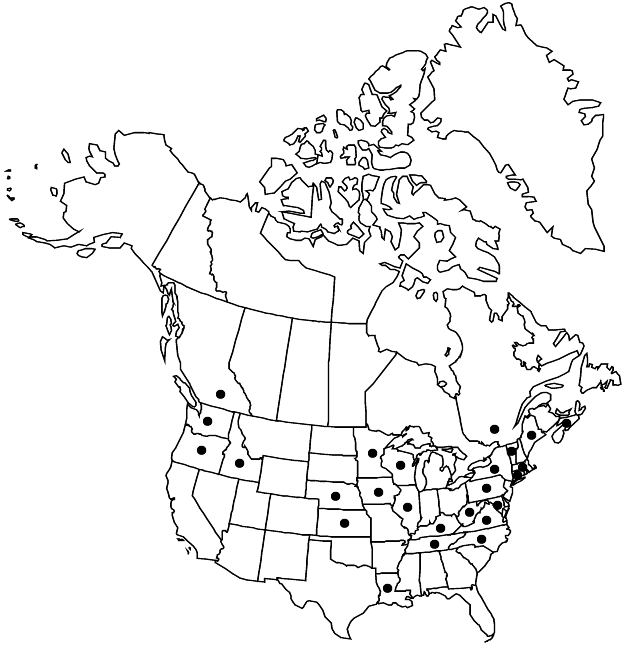Fallopia ×bohemica
Watsonia 17: 443. 1989.
Herbs, perennial, rhizomatous, 1.5–2.5 m. Stems usually clustered, erect, profusely branched, herbaceous, stiff, glabrous, glaucous. Leaves: ocrea usually deciduous, brownish, cylindric, 4–6(–10) mm, margins oblique, face without reflexed hairs and slender bristles at base, otherwise glabrous or minutely puberulent; petiole 1–3 cm, glabrous; blade ovate, 5–25(–30) × 2–10 cm, base truncate to cordate, margins entire, glabrous or scabrous to ciliate, apex cuspidate, abaxial face minutely dotted, glaucous, with hairs along veins unicellular or appearing so, obscure, shorter than 0.1 mm, tips acute, adaxial face glabrous. Inflorescences terminal and axillary, erect or spreading, paniclelike or sometimes racemelike, 4–12 cm, axes puberulent; peduncle 0.1–3.5 cm or absent, puberulent. Pedicels ascending or spreading, articulated proximal to middle, 3–5 mm, glabrous. Flowers bisexual or pistillate, 3–8(–15) per ocreate fascicle; perianth accrescent in fruit, white or greenish white to pink, 4–6 mm including stipelike base, glabrous; tepals obovate to elliptic, apex obtuse to acute, outer 3 winged; stamens 8; filaments flattened proximally, glabrous; styles connate basally; stigmas fimbriate. Achenes included, dark brown, 2.6–3.2 × 1.4–1.8 mm, shiny, smooth; fruiting perianth glabrous, wings flat to undulate, 1.5–2.1 mm wide at maturity, decurrent on stipelike base nearly to articulation, margins entire. 2n = 44, 66, 88 (Korea).
Phenology: Flowering Jul–Oct.
Habitat: Disturbed places
Elevation: 0-800 m
Distribution

B.C., N.S., Que., Conn., Idaho, Ill., Iowa, Kans., Ky., La., Maine, Md., Mass., Minn., Nebr., N.Y., N.C., Oreg., Pa., Tenn., Vt., Va., Wash., W.Va., Wis., Europe.
Discussion
Fallopia ×bohemica is a widespread hybrid between F. japonica and F. sachalinensis. It went unnoticed in the North American flora until recently (P. F. Zika and A. L. Jacobson 2003). It exhibits morphological intermediacy with its parents and is distinguished most reliably by the pubescence along the veins on the abaxial surface of leaves produced early in the growing season. Hairs of F. sachalinensis are multicellular, usually twisted, acute to acuminate at the tip, and 0.2–0.6 mm; those of F. japonica are unicellular, blunt, and barely raised, making the veins appear scabrous. Fallopia ×bohemica has hairs that are unicellular or appearing so (actually often obscurely multicelluar), acute at the tip, and shorter than 0.1 mm. The hairs are easiest to find on fresh leaves; older leaves often are glabrescent and diagnostic hairs are hard to find. Hybrid specimens are most often misidentified as F. japonica.
Like its parents, Fallopia ×bohemica is gynodioecious. J. P. Bailey et al. (1996) reported it to be partially to fully fertile. In North America, reproduction appears to be largely vegetative by rhizomes.